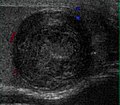Scrotal ultrasound
Scrotal ultrasound is a medical imaging technique that uses high-frequency sound waves to produce images of the scrotum and the testicles. It is a non-invasive procedure that is used to diagnose a variety of conditions, such as testicular torsion, epididymitis, and hydrocele.
Overview[edit]
A scrotal ultrasound is often used to evaluate lumps in the scrotum, which can be caused by a variety of conditions. These include testicular cancer, varicocele, and spermatocele. The procedure can also be used to evaluate pain or swelling in the scrotum, to locate a testicle that has not descended into the scrotum, or to evaluate a possible testicular torsion.
Procedure[edit]
During a scrotal ultrasound, the patient lies on his back with his legs spread. A clear gel is applied to the scrotum to help the ultrasound waves pass through the skin. The sonographer then moves a handheld device called a transducer over the scrotum. The transducer emits high-frequency sound waves that bounce off the structures in the scrotum. These echoes are converted into images on a monitor.
Risks and Complications[edit]
A scrotal ultrasound is a safe procedure with minimal risks. However, some patients may experience slight discomfort from the pressure of the transducer, especially if the scrotum is already tender or inflamed.
Results[edit]
The results of a scrotal ultrasound can help diagnose a variety of conditions. For example, a solid mass in the testicle may indicate testicular cancer, while fluid around the testicle may indicate a hydrocele. The procedure can also help determine whether a lump is inside or outside the testicle, which can help guide further treatment.
See Also[edit]
|
|
|
Scrotal ultrasound[edit]
-
Ultrasonography of a normal testicle
-
Ultrasonography of a normal epididymal head
-
Ultrasonography of an appendix on a testicle in a hydrocele
-
Ultrasound images of seminomas
-
Ultrasonography of embryonal cell carcinoma
-
Ultrasonography of teratoma
-
Ultrasonographies of mature cystic teratomas
-
Scrotal ultrasonography of lymphoma
-
Scrotal ultrasonography of primary lymphoma
-
Scrotal ultrasonography of leukemia
-
Scrotal ultrasonography of epidermoid cyst
-
Scrotal ultrasonography of rhabdomyosarcoma
Ad. Transform your life with W8MD's Budget GLP-1 injections from $75


W8MD offers a medical weight loss program to lose weight in Philadelphia. Our physician-supervised medical weight loss provides:
- Weight loss injections in NYC (generic and brand names):
- Zepbound / Mounjaro, Wegovy / Ozempic, Saxenda
- Most insurances accepted or discounted self-pay rates. We will obtain insurance prior authorizations if needed.
- Generic GLP1 weight loss injections from $75 for the starting dose.
- Also offer prescription weight loss medications including Phentermine, Qsymia, Diethylpropion, Contrave etc.
NYC weight loss doctor appointmentsNYC weight loss doctor appointments
Start your NYC weight loss journey today at our NYC medical weight loss and Philadelphia medical weight loss clinics.
- Call 718-946-5500 to lose weight in NYC or for medical weight loss in Philadelphia 215-676-2334.
- Tags:NYC medical weight loss, Philadelphia lose weight Zepbound NYC, Budget GLP1 weight loss injections, Wegovy Philadelphia, Wegovy NYC, Philadelphia medical weight loss, Brookly weight loss and Wegovy NYC
|
WikiMD's Wellness Encyclopedia |
| Let Food Be Thy Medicine Medicine Thy Food - Hippocrates |
Medical Disclaimer: WikiMD is not a substitute for professional medical advice. The information on WikiMD is provided as an information resource only, may be incorrect, outdated or misleading, and is not to be used or relied on for any diagnostic or treatment purposes. Please consult your health care provider before making any healthcare decisions or for guidance about a specific medical condition. WikiMD expressly disclaims responsibility, and shall have no liability, for any damages, loss, injury, or liability whatsoever suffered as a result of your reliance on the information contained in this site. By visiting this site you agree to the foregoing terms and conditions, which may from time to time be changed or supplemented by WikiMD. If you do not agree to the foregoing terms and conditions, you should not enter or use this site. See full disclaimer.
Credits:Most images are courtesy of Wikimedia commons, and templates, categories Wikipedia, licensed under CC BY SA or similar.
Translate this page: - East Asian
中文,
日本,
한국어,
South Asian
हिन्दी,
தமிழ்,
తెలుగు,
Urdu,
ಕನ್ನಡ,
Southeast Asian
Indonesian,
Vietnamese,
Thai,
မြန်မာဘာသာ,
বাংলা
European
español,
Deutsch,
français,
Greek,
português do Brasil,
polski,
română,
русский,
Nederlands,
norsk,
svenska,
suomi,
Italian
Middle Eastern & African
عربى,
Turkish,
Persian,
Hebrew,
Afrikaans,
isiZulu,
Kiswahili,
Other
Bulgarian,
Hungarian,
Czech,
Swedish,
മലയാളം,
मराठी,
ਪੰਜਾਬੀ,
ગુજરાતી,
Portuguese,
Ukrainian














